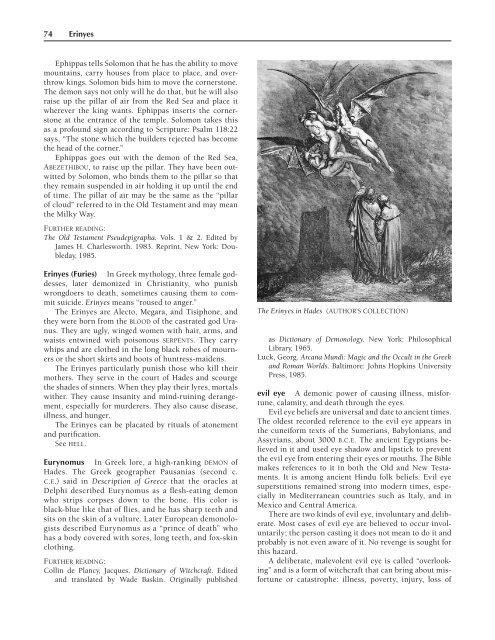The Encyclopedia Of Demons And Demonology
The Encyclopedia Of Demons And Demonology
The Encyclopedia Of Demons And Demonology
Create successful ePaper yourself
Turn your PDF publications into a flip-book with our unique Google optimized e-Paper software.
74 Erinyes<br />
Ephippas tells Solomon that he has the ability to move<br />
mountains, carry houses from place to place, and overthrow<br />
kings. Solomon bids him to move the cornerstone.<br />
<strong>The</strong> demon says not only will he do that, but he will also<br />
raise up the pillar of air from the Red Sea and place it<br />
wherever the king wants. Ephippas inserts the cornerstone<br />
at the entrance of the temple. Solomon takes this<br />
as a profound sign according to Scripture: Psalm 118:22<br />
says, “<strong>The</strong> stone which the builders rejected has become<br />
the head of the corner.”<br />
Ephippas goes out with the demon of the Red Sea,<br />
ABEZETHIBOU, to raise up the pillar. <strong>The</strong>y have been outwitted<br />
by Solomon, who binds them to the pillar so that<br />
they remain suspended in air holding it up until the end<br />
of time. <strong>The</strong> pillar of air may be the same as the “pillar<br />
of cloud” referred to in the Old Testament and may mean<br />
the Milky Way.<br />
FURTHER READING:<br />
<strong>The</strong> Old Testament Pseudepigrapha. Vols. 1 & 2. Edited by<br />
James H. Charlesworth. 1983. Reprint, New York: Doubleday,<br />
1985.<br />
Erinyes (Furies) In Greek mythology, three female goddesses,<br />
later demonized in Christianity, who punish<br />
wrongdoers to death, sometimes causing them to commit<br />
suicide. Erinyes means “roused to anger.”<br />
<strong>The</strong> Erinyes are Alecto, Megara, and Tisiphone, and<br />
they were born from the BLOOD of the castrated god Uranus.<br />
<strong>The</strong>y are ugly, winged women with hair, arms, and<br />
waists entwined with poisonous SERPENTS. <strong>The</strong>y carry<br />
whips and are clothed in the long black robes of mourners<br />
or the short skirts and boots of huntress-maidens.<br />
<strong>The</strong> Erinyes particularly punish those who kill their<br />
mothers. <strong>The</strong>y serve in the court of Hades and scourge<br />
the shades of sinners. When they play their lyres, mortals<br />
wither. <strong>The</strong>y cause insanity and mind-ruining derangement,<br />
especially for murderers. <strong>The</strong>y also cause disease,<br />
illness, and hunger.<br />
<strong>The</strong> Erinyes can be placated by rituals of atonement<br />
and purification.<br />
See HELL.<br />
Eurynomus In Greek lore, a high-ranking DEMON of<br />
Hades. <strong>The</strong> Greek geographer Pausanias (second c.<br />
C.E.) said in Description of Greece that the oracles at<br />
Delphi described Eurynomus as a flesh-eating demon<br />
who strips corpses down to the bone. His color is<br />
black-blue like that of flies, and he has sharp teeth and<br />
sits on the skin of a vulture. Later European demonologists<br />
described Eurynomus as a “prince of death” who<br />
has a body covered with sores, long teeth, and fox-skin<br />
clothing.<br />
FURTHER READING:<br />
Collin de Plancy, Jacques. Dictionary of Witchcraft. Edited<br />
and translated by Wade Baskin. Originally published<br />
<strong>The</strong> Erinyes in Hades (AUTHOR’S COLLECTION)<br />
as Dictionary of <strong>Demonology</strong>. New York: Philosophical<br />
Library, 1965.<br />
Luck, Georg. Arcana Mundi: Magic and the Occult in the Greek<br />
and Roman Worlds. Baltimore: Johns Hopkins University<br />
Press, 1985.<br />
evil eye A demonic power of causing illness, misfortune,<br />
calamity, and death through the eyes.<br />
Evil eye beliefs are universal and date to ancient times.<br />
<strong>The</strong> oldest recorded reference to the evil eye appears in<br />
the cuneiform texts of the Sumerians, Babylonians, and<br />
Assyrians, about 3000 B.C.E. <strong>The</strong> ancient Egyptians believed<br />
in it and used eye shadow and lipstick to prevent<br />
the evil eye from entering their eyes or mouths. <strong>The</strong> Bible<br />
makes references to it in both the Old and New Testaments.<br />
It is among ancient Hindu folk beliefs. Evil eye<br />
superstitions remained strong into modern times, especially<br />
in Mediterranean countries such as Italy, and in<br />
Mexico and Central America.<br />
<strong>The</strong>re are two kinds of evil eye, involuntary and deliberate.<br />
Most cases of evil eye are believed to occur involuntarily;<br />
the person casting it does not mean to do it and<br />
probably is not even aware of it. No revenge is sought for<br />
this hazard.<br />
A deliberate, malevolent evil eye is called “overlooking”<br />
and is a form of witchcraft that can bring about misfortune<br />
or catastrophe: illness, poverty, injury, loss of












